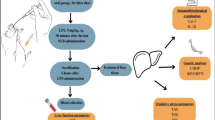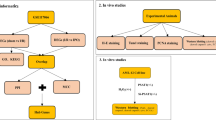Abstract
Background and Methods
Acute liver failure after massive hepatectomy remains a challenging problem. In this study, using a microarray designed to monitor the side effects of drugs, we examined changes in gene expression in the remnant liver during the 24 h after hepatectomy and the effects of a nontoxic heat shock protein (HSP) 70 inducer, geranylgeranylacetone (GGA), after 90% hepatectomy in rats.
Results
A single oral administration of 100 mg/kg GGA significantly suppressed the release of aminotransferases and improved survival compared with vehicle administration. The hepatectomy upregulated 74 genes and downregulated 95. Interestingly, ten cytokine genes were upregulated, while no cytokine-related gene was downregulated. Among the ten cytokine genes, a potent chemoattractant for neutrophils, GRO1, was most rapidly and markedly upregulated after 90% hepatectomy. GGA effectively suppressed the up-regulation of GRO1 messenger ribonucleic acid, and this was validated by Northern hybridization. Microarray and immunoblot analyses showed that, in addition to HSP70 and HSP27, GGA preferentially induced an endoplasmic reticulum chaperone, BIP.
Conclusion
Considering hemodynamic and metabolic overloading as a primary cause of acute lever failure, the ER stress response enhanced by GGA may also play an important role in the prevention of overload-induced liver damage.





Similar content being viewed by others

References
Grazi GL, Mazziotti A, Jovine E, et al. Total vascular exclusion of the liver during hepatic surgery. Arch Surg 1997;132:1104–1109.
Matsumata T, Taketomi A, Kawahara H, et al. Mortality and morbidity after hepatic resection in the modern era. Hepatogastroenterol 1995;42:456–460.
Mochida S, Ogata I, Hirata K, Ohta Y, Yamada S, Fujikawa K. Provocation of massive hepatic necrosis by endotoxin after partial hepatectomy in rats. Gastroenterology 1990;99:771–777.
Callery MP, Mangino MJ, Flye MW. A biologic basis for limited Kupffer cell reactivity to portal-derived endotoxin. Surgery 1991;110:221–230.
Wang XD, Soltesz V, Andersson R, Bengmark S. Bacterial translocation in acute liver failure induced by 90 per cent hepatectomy in the rat. Br J Surg 1993;80:66–71. doi:10.1002/bjs.1800800124.
Callery MP, Kamai T, Flye MW. Kupffer cell tumor necrosis factor-alpha production is suppressed during liver regeneration. J Surg Res 1991;50:515–519. doi:10.1016/0022-4804(91)90034-J.
Leist M, Gantner F, Bohlinger I, Tiegs G, Germann PG, Wendel A. Tumor necrosis factor-induced hepatocyte apoptosis precedes liver failure in experimental murine shock models. Am J Pathol 1995;146:1220–1234.
Panis Y, Mcmullan DM, Emond JC. Progressive necrosis after hepatectomy and the pathophysiology of liver failure after massive resection. Surgery 1997;121:142–149. doi:10.1016/S0039–6060(97)90283-X.
Andiran F, Ayhan A, Tanyel FC, Abbasoglu O, Sayek I. Regenerative capacities of normal and cirrhotic livers following 70% hepatectomy in rats and the effect of a-tocophenol on cirrhotic regeneration. J Surg Res 2000;89:184–188. doi:10.1006/jsre.2000.5825.
Hasegawa S, Kubota T, Fukuyama N, Kurosawa H, Sekido H, Togo S, et al. Apoptosis of hepatocytes is a main cause of inducing lethal hepatic failure after excessive hepatectomy in rats. Transplant Proc 1999;31:558–559. doi:10.1016/S0041-1345(98)01554-1.
Hartl FU. Molecular chaperones in cellular protein folding. Nature 1996;381:571–579. doi:10.1038/381571a0.
Weich WJ. Mammalian stress response: Cell physiology, structure/function of stress protein, and implications for medicine and disease. Physiol Rev 1992;72:1063–1081.
Minowada G, Welch WJ. Clinical implications of the stress response. J Clin Invest 1995;95:3–12. doi:10.1172/JCI117655.
Ikeyama S, Kusumoto K, Miyaka H, Rokutan K, Tashiro S. A non-toxic heat shock protein 70 inducer, geranylgeranylacetone, suppress apoptosis of cultured rat hepatocytes caused by hydrogen peroxide and ethanol. J Hepatol 2001;35:53–61. doi:10.1016/S0168-8278(01)00053-8.
Yamagami K, Yamamoto Y, Ishikawa Y, Yonezawa K, Toyokuni S, Yamaoka Y. Effects of geranyl-geranyl-acetone administration before heat shock preconditioning for conferring tolerance against ischemia–reperfusion injury in rat livers. J Lab Clin Med 2000;135:465–475. doi:10.1067/mlc.2000.106806.
Oda H, Miyake H, Iwata T, Kusumoto K, Rokutan K, Tashiro S. Geranylgeranylacetone suppresses inflammatory responses and improves survival after massive hepatectomy in rats. J Gastrointest Surg 2002;6:464–473. doi:10.1016/S1091-255X(01)00043-9.
Fudaba Y, Tashiro H, Ohdan H, Miyata Y, Shibata S, Shintaku S, et al. Prevention of warm ischemic injury in rat liver transplantation by geranylgeranylacetone. Transplant Proc 2000;32:1615–1616. doi:10.1016/S0041-1345(00)01449-4.
Bozic CR, Kolakowski LF Jr, Gerard NP, Garcia-Rodriguez C, von Uexkull-Guldenband C, Conklyn MJ, et al. Expression and biologic characterization of the murine chemokine KC. J Immunol 1995;154:6048–6057.
Song F, Ito K, Denning TL, Kuninger D, Papaconstantinou J, Gourley W, et al. Expression of the neutrophil chemokine KC in the colon of mice with enterocolitis and by intestinal epithelial cell lines: Effects of flora and proinflammatory cytokines. J Immunol 1999;162:2275–2280.
Wang JM, Deng X, Gong W, Su S. Chemokines and their role in tumor growth and metastasis. J Immunol Methods 1998;220:1–17. doi:10.1016/S0022-1759(98)00128-8.
Dong G, Loukinova E, Smith CW, Chen Z, Van Waes C. Genes differentially expressed with malignant transformation and metastatic tumor progression of murine squamous cell carcinoma. J Cell Biochem Suppl 1997;28/29:90–100. doi:10.1002/(SICI)1097-4644(1997)28/29+<90::AID-JCB10>3.0.CO;2-K.
Van Der Meeren A, Monti P, Lebaron-Jacobs L, Marquette C, Gourmelon P. Characterization of the acute inflammatory response after irradiation in mice and its regulation by interleukin 4 (IL4). Radiat Res 2001;155:858–865. doi:10.1667/0033-7587(2001)155[0858:COTAIR]2.0.CO;2.
Hayakawa K, Hiramatsu N, Okamura M, Yao J, Paton AW, Paton JC, et al. Blunted activation of NF-kB and NF-kB-dependent gene expression by geranylgeranylacetone: involvement of unfolded protein response. Biochem Biophys Res Commun 2008;365:47–53. doi:10.1016/j.bbrc.2007.10.115.
Tanaka K, Tsutsumi S, Arai Y, Hoshino T, Suzuki K, Takaki E, et al. Genetic evidence for a protective role of heat shock factor 1 against irritant-induced gastric lesions. Mol Pharmacol 2007;71:985–993. doi:10.1124/mol.106.033282.
Yenari MA, Liu J, Zheng ZZ, Vexler ZS, Lee JE, Giffard RG. Antiapoptotic and anti-inflammatory mechanisms of heat-shock protein protection. Ann NY Acad Sci 2005;1053:74–83. doi:10.1196/annals.1344.007.
Kim HP, Wang X, Zhang J, Suh GY, Benjamin IJ, Ryter SW, et al. Heat shock protein-70 mediates the cytoprotective effect of carbon monoxide: involvement of p38 MAPK and heat shock factor-1. J Immunol 2005;175:2622–2629.
Van Molle W, Wielockx B, Mahieu T, Takada M, Taniguchi T, Sekikawa K, et al. HSP70 protects against TNF-induced lethal inflammatory shock. Immunity 2002;16:685–695. doi:10.1016/S1074-7613(02)00310-2.
Wang Y, Li C, Wang X, Zhang J, Chang Z. Heat shock response inhibits IL-18 expression through the JNK pathway in murine peritoneal macrophages. Biochem Biophys Res Commun 2002;296:742–748. doi:10.1016/S0006-291X(02)00930-0.
Shi Y, Tu Z, Tang D, Zhang H, Liu M, Wang K, et al. The inhibition of LPS-induced production of inflammatory cytokines by HSP70 involves inactivation of the NF-kB pathway but not the MAPK pathways. Shock 2006;26:277–284. doi:10.1097/01.shk.0000223134.17877.ad.
Tang D, Kang R, Xiao W, Wang H, Calderwood SK, Xiao X. The anti-inflammatory effects of heat shock protein 72 involve inhibition of high-mobility-group box 1 release and proinflammatory function in macrophages. J Immunol 2007;179:1236–1244.
Arrigo AP. The cellular “networking” of mammalian Hsp27 and its functions in the control of protein folding, redox state and apoptosis. Adv Exp Med Biol 2007;594:14–26.
Kleizen B, Braakman I. Protein folding and quality control in the endoplasmic reticulum. Curr Opin Cell Biol 2004;16:343–349. doi:10.1016/j.ceb.2004.06.012.
Bertolotti A, Zhang Y, Hendershot LM, Harding HP, Ron D. Dynamic interactions between BiP and the ER stress receptors IRE1 and PERK in the unfolded protein response. Nat Cell Biol 2000;2:326–332. doi:10.1038/35014014.
Author information
Authors and Affiliations
Corresponding author
Rights and permissions
About this article
Cite this article
Kanemura, H., Kusumoto, K., Miyake, H. et al. Geranylgeranylacetone Prevents Acute Liver Damage after Massive Hepatectomy in Rats through Suppression of a CXC Chemokine GRO1 and Induction of Heat Shock Proteins. J Gastrointest Surg 13, 66–73 (2009). https://doi.org/10.1007/s11605-008-0604-x
Received:
Accepted:
Published:
Issue Date:
DOI: https://doi.org/10.1007/s11605-008-0604-x



